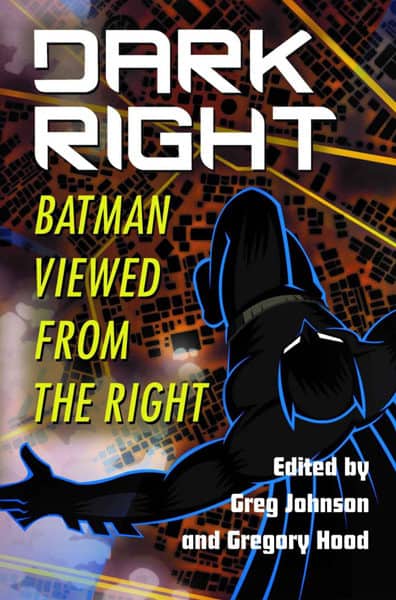The Dark Right
Paul Kersey, American Renaissance, February 22, 2019
A long time ago, in a nation far, far away, young white boys watched Disney’s Davy Crockett television program and dreamed of emulating this heroic white pioneer who helped tame the wild American frontier, making it safe for our civilization’s advance. The appeal of the show helped make his signature raccoon skin hat a ubiquitous item for boys to wear in the 1950s, with more than 5,000 sold per day at the height of the program’s fandom.
Unfortunately, the past is a different country. Coon skin caps have been retired. Today, young boys (and some adult men) have adopted the mantle of commercialized superheroes — Superman, Spiderman, Captain America, The Flash, Green Lantern, and Batman.
Instead of playing Cowboys and Indians, many kids pretend they are one of The Avengers — characters conveniently owned and licensed by Disney. In fact, in 2017’s Spiderman: Homecoming (the third reboot in the franchise and the sixth film portraying the Friendly Neighborhood Wallcrawler in 15 years), there’s even a line referencing this cultural change. A character comments on the sudden appearance of aliens and superhumans in his world and says, “When I was a kid, I used to draw cowboys and Indians.”
He’s stopped mid-sentence. One of his co-workers tells him, “Actually, it’s Native American.”
Davy Crockett has no place in modern America. Instead, ideologies promoting egalitarianism, white guilt, and “anti-fascism” prevail. These dominant ideas are promoted through mass culture — even in superhero movies. With tens of billions of dollars being generated by these characters, the Dissident Right needs to carefully analyze — and if necessary, combat — the kinds of messages being promoted.
Dark Right: Batman Viewed from the Right is an important step in this direction. Few on the Right understand the importance of engaging popular culture like Dr. Greg Johnson and Gregory Hood, the two men who edit this vital collection of essays on Bruce Wayne’s alter-ego, Batman.

Since 1989’s Batman — which, when adjusted for inflation, is still one of the highest grossing movies ever made — there have been an astonishing eight additional films about the Dark Knight.
Three of those were the highly-acclaimed Christopher Nolan trilogy, starring Christian Bale as Batman. The two most recent films, Batman v. Superman and Justice League, cast Ben Affleck in the iconic role, and were largely forgettable.
There is a whole industry of scholars analyzing and reviewing the superhero genre from the Left. Unfortunately, Dark Right is one of the few works of criticism from the Right. In the editors’ introduction, Dr. Johnson and Mr. Hood explain why a scholarly work looking at the Caped Crusader through the prism of right-wing thought is a worthy undertaking.
Why a collection of essays viewing Batman from the Right? The entire superhero genre is inherently anti-liberal, for even though superheroes generally fight for liberal humanist values, they do so outside the law. They are vigilantes. But vigilantism only becomes necessary when the liberal legal order fails to secure justice. This implies that, ultimately, we are not governed by laws, but by men. (p. 9)
In a fine review of 2012’s The Dark Knight Rises, Trevor Lynch argues that what would seem to be a children’s genre deserves serious attention from those who want to change the world.
Tens of millions of young whites are eagerly watching and analyzing these films. Thus it is important for us to use these films to communicate our ideas. Yes, Hollywood always puts our ideas in the mouths of psychotics in order to immunize people against them. But these ideas are one reason why the villains are always more interesting than Batman, who merely comes off as a tool. (p. 39)
One of the book’s highlights is contributions from the late Jonathan Bowden, who was something of an expert at analyzing the deeper messages of pop culture, and his unique insight into two of the more popular Batman graphic novels, Arkham Asylum and Batman: The Killing Joke, are well worth reading.
In one of his contributions, Mr. Hood’s review of The Dark Knight Rises, the author slams the inability of Conservatism Inc. reviewers to understand the ideas of the film. He shows that even when reviewing a superhero movie, Beltway Right hacks can’t even understand concepts that don’t fit within their narrow ideology. More importantly, both liberals and “conservatives” fundamentally agree about the value of egalitarianism, so they don’t have anything important to argue about, even when it comes to analyzing pop culture.
Christopher Nolan created a Right-wing film that conservatives are attracted to, but will never truly understand. They can’t explain why they like the movie because that requires a new vocabulary drawn from Tradition and the European New Right. Lacking that, we get paeans to the Caped Crusader’s fight against clean energy. Still, American conservatives instinctually claim anything with sublimated right-wing tenancies as their own. All politics is downstream from culture, and unfortunately for conservatives, they lost that battle quite some time ago. However, the impulse for an authentic Right is still there, and the real culture war never truly ends. (p. 65-66)
Far from ending, the battle seems to be intensifying in recent years. While the likes of Davy Crockett have long since vanished, there are subversive ideas and concepts slipping into today’s movie blockbusters. Dr. Johnson and Mr. Hood’s book is an important weapon in that never-ending cultural war. Pop culture isn’t just a product, it’s way to communicate ideas. Young whites who read The Dark Right will be better able to resist to poison being pushed on them by the mass media. Maybe one day, we can have a society that values our historical heroes rather than the creations of a corporation.















